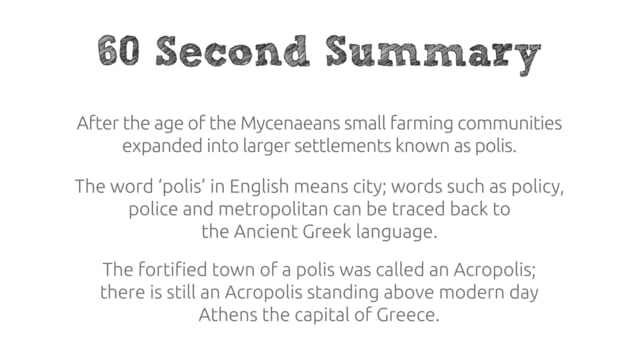This video covers: Following on from the Minoans and the Mycenaean, we take a look at how Ancient Greece developed
In around eight hundred BC small farming communities began to expand into larger settlements. These settlements extended from mainland Greece to the islands scattered around the Aegean Sea and across into what’s now called Turkey. All these separate settlements were known as city states or polis, there were thousands of them and they were independent of each other, each being ruled by their own ruler or king and having their own laws. Each polis, or city-state, had a central town surrounded by smaller villages and farmland. The central town was called an Acropolis, which means ‘high city’ as it was built around the top of a hill. The Acropolis was fortified with a wall around it so it offered protection to its people in time of war and, being on a hill, they could see their attackers coming. Each of these polis had its own traditions and government so Ancient Greece wasn’t just one country but a group of small nations. When some of the rulers or kings became unpopular they were overthrown by the people, it was when this happened that the first democratic governments began.
Eras:
Ancient Greece
Topics:
Civilizations
Democracy
Character:
Greek philosopher
Key words:
Greece, Ancient Greece, Greek, Ancient Greek, polis, Turkey, Aegean, Aegean Sea, city states, ruler, king, acropolis, fortified, government, democracy, democratic, democratic government, Video, history video, BC, settlements, KS2, Year 3, Year 4, Year 5, Year 6, Key Stage 2, KS2, key stage 2, key stage 2 history, primary, KS2 videos, KS2 clips, KS2 history, KS2 videos, KS2 history film, KS2 history clip, Greece, Greek, Grecian, Ancient Greece, Ancient Greek, Y3, Y4, Y5, Y6, Year 3, Year 4, Year 5, Year 6,


